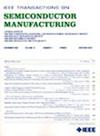Improving Endpoint Detection Sensitivity in Plasma Etching With Small Openings
IF 2.3
3区 工程技术
Q2 ENGINEERING, ELECTRICAL & ELECTRONIC
引用次数: 0
Abstract
We propose a method that enables real-time endpoint detection during plasma etching of small openings (the absolute area of the opening is at or below 5%) on a wafer. Traditional endpoint detection techniques rely on observing changes in specific wavelengths, which perform well for wafers with larger openings. However, as integrated circuit manufacturing processes continue to develop towards miniaturization, real-time endpoint detection in small opening areas remains a significant challenge. This method utilizes strategies such as hybrid noise reduction, dimensionality reduction, and interpolation to achieve real-time monitoring of etching status. First of all, a spectrometer is used to monitor chamber status in real time and provide spectral data. The wavelet threshold combined with median filtering was used to denoise the data, the SNR of the spectral signal processed by the mixed strategy increases by 37.87% compared to that of the noisy signal. What’s more, 86.96% dimensionality reduction can be achieved through the spectral data dimensionality reduction rule. Finally, an offline model was constructed using a three-time spline interpolation for the selected feature wavelengths. Compared with other strategies, the sensitivity of endpoint detection in small opening areas of the model constructed by the above algorithm is increased by 13.2%.提高小开口等离子体蚀刻的端点检测灵敏度
我们提出了一种方法,可以在等离子体蚀刻晶圆上的小开口(开口的绝对面积等于或低于5%)时实现实时端点检测。传统的端点检测技术依赖于观察特定波长的变化,这对于开口较大的晶圆来说表现良好。然而,随着集成电路制造工艺不断向小型化发展,小开口区域的实时端点检测仍然是一个重大挑战。该方法采用混合降噪、降维和插值等策略来实现对蚀刻状态的实时监测。首先,使用光谱仪实时监测腔室状态并提供光谱数据。采用小波阈值与中值滤波相结合的方法对数据进行降噪处理,经混合策略处理后的频谱信号的信噪比较含噪信号提高了37.87%。其中,通过谱数据降维规则可以实现86.96%的降维。最后,对所选特征波长进行三次样条插值,构建离线模型。与其他策略相比,该算法构建的模型在小开口区域的端点检测灵敏度提高了13.2%。
本文章由计算机程序翻译,如有差异,请以英文原文为准。
求助全文
约1分钟内获得全文
求助全文
来源期刊

IEEE Transactions on Semiconductor Manufacturing
工程技术-工程:电子与电气
CiteScore
5.20
自引率
11.10%
发文量
101
审稿时长
3.3 months
期刊介绍:
The IEEE Transactions on Semiconductor Manufacturing addresses the challenging problems of manufacturing complex microelectronic components, especially very large scale integrated circuits (VLSI). Manufacturing these products requires precision micropatterning, precise control of materials properties, ultraclean work environments, and complex interactions of chemical, physical, electrical and mechanical processes.
 求助内容:
求助内容: 应助结果提醒方式:
应助结果提醒方式:


